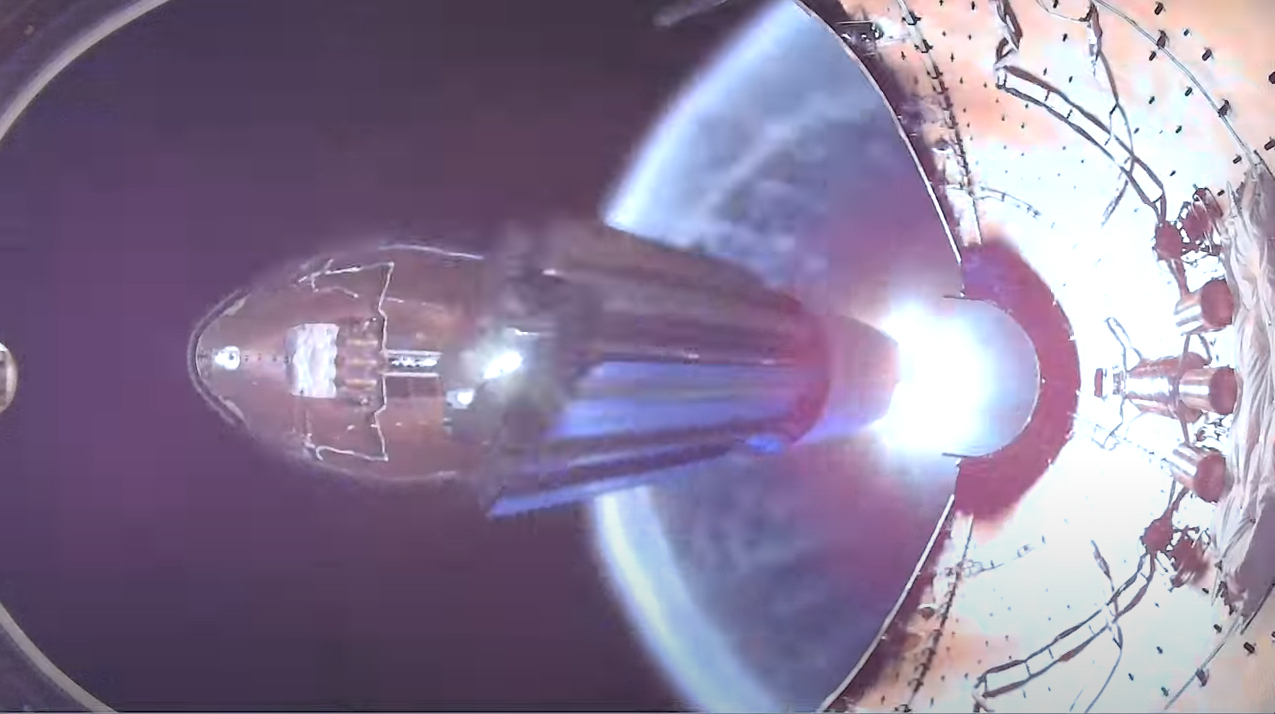Dramatic SpaceX video shows what happens when a rocket's nose cone pops off
Payload fairing separation, when a rocket's shell-like nose cone pops free, is an event that accompanies most rocket launches these days, but we've never seen one quite like this.
A stunning new video from SpaceX captures the moment of separation from the point of view of the fairing itself, showing the two halves of a Falcon 9 rocket's fairing pull away from the booster's upper stage during a recent launch of 60 Starlink internet satellites.
In the 9-second clip, which SpaceX released on YouTube, we see the fairings separate from the Falcon 9 upper stage to reveal a towering stack of Starlink satellites. A quick glimpse of the Earth's atmosphere, backlit with ethereal blue light, can be seen just before it ends. SpaceX launched the Starlink mission June 3 from Space Launch Complex 40 of the Cape Canaveral Air Force Station in Florida.
Related: SpaceX's Starlink satellite megaconstellation launches in photos

SpaceX's Falcon 9 payload fairings are 43 feet (13 meters) tall and just over 17 feet (5 m) wide. When assembled, they form a shell around satellite payloads to protect them during the first few minutes of a launch. The fairing halves separate about 3 minutes after liftoff. (SpaceX's Dragon spacecraft, which carry cargo and crew to space, aren't covered by a fairing.)
SpaceX has added steering thrusters and parachutes to some fairing halves in order to reuse the fairings on multiple flights. To catch them in the ocean, SpaceX has added giant nets to two retrieval ships, called Ms. Tree and Ms. Chief, to recover the fairings at sea.
According to SpaceX founder and CEO Elon Musk, Falcon 9 rocket fairings alone cost $6 million, so reusing them on multiple flights can help lower launch costs. The company has reflown three fairing halves to date.
Get the Space.com Newsletter
Breaking space news, the latest updates on rocket launches, skywatching events and more!
The next SpaceX launch will lift off Saturday (June 13) and will carry another 60 Starlink satellites into orbit. SpaceX has launched 482 Starlink satellites over eight missions as the company works to build a 12,000-satellite megaconstellation to provide high-speed internet service around the world.
- SpaceX's rocket payload fairing-catching boat in photos
- SpaceX's Starlink broadband service will begin in 2020: Report
- Why SpaceX's Starlink satellites caught astronomers off guard
Email Tariq Malik at tmalik@space.com or follow him @tariqjmalik. Follow us @Spacedotcom, Facebook and Instagram.
OFFER: Save 45% on 'All About Space' 'How it Works' and 'All About History'!
For a limited time, you can take out a digital subscription to any of our best-selling science magazines for just $2.38 per month, or 45% off the standard price for the first three months.
Join our Space Forums to keep talking space on the latest missions, night sky and more! And if you have a news tip, correction or comment, let us know at: community@space.com.

Tariq is the Editor-in-Chief of Space.com and joined the team in 2001, first as an intern and staff writer, and later as an editor. He covers human spaceflight, exploration and space science, as well as skywatching and entertainment. He became Space.com's Managing Editor in 2009 and Editor-in-Chief in 2019. Before joining Space.com, Tariq was a staff reporter for The Los Angeles Times covering education and city beats in La Habra, Fullerton and Huntington Beach. In October 2022, Tariq received the Harry Kolcum Award for excellence in space reporting from the National Space Club Florida Committee. He is also an Eagle Scout (yes, he has the Space Exploration merit badge) and went to Space Camp four times as a kid and a fifth time as an adult. He has journalism degrees from the University of Southern California and New York University. You can find Tariq at Space.com and as the co-host to the This Week In Space podcast with space historian Rod Pyle on the TWiT network. To see his latest project, you can follow Tariq on Twitter @tariqjmalik.
-
c_glensmith Wow, that is very cool.Reply
The streamers coming off the nose cone look slower than I would expect, anyone got any idea what the altitude and atmosphere density is? -
Torbjorn Larsson Good catch! They obviously want to pop the fairing when atmosphere drag is no longer a problem.Reply
I googled that SpaceX use a fairly constant 150ish km altitude, which is above the Karman line at 100 km, which is when you can in theory propel a low Earth orbit satellite in orbit. It is rather the altitude of many low Earth orbit satellite which are later either propelled up or spontaneously dragged down over many orbits.
The scale height (the atmosphere height where you have passed 1-1/e or 60 % of atmosphere mass) of Earth is a low 8 km, which is easy to remember - Mount Everest climbers breathe 60 % of ocean height oxygen - and nothing like the scale height of 1.5 Earth atmosphere pressure Titan which scale height is something like ~ 100 km - but then again colder atmospheres are non-intuitively higher.
If the atmosphere density goes exponential as the scale height measure suggest, another 10 e-folds would give you something like e^-10 or ~ 2^-10 or ~ 10^-5 atmospheres density. -
PLF Why do you use nose cone in the title of the article? Let’s educate and use the proper terminology of “payload fairing”. ThanksReply -
Alpha1 Payload fairing is correct. But for the layman reader, 'Nose cone' is perfectly adequate.Reply











